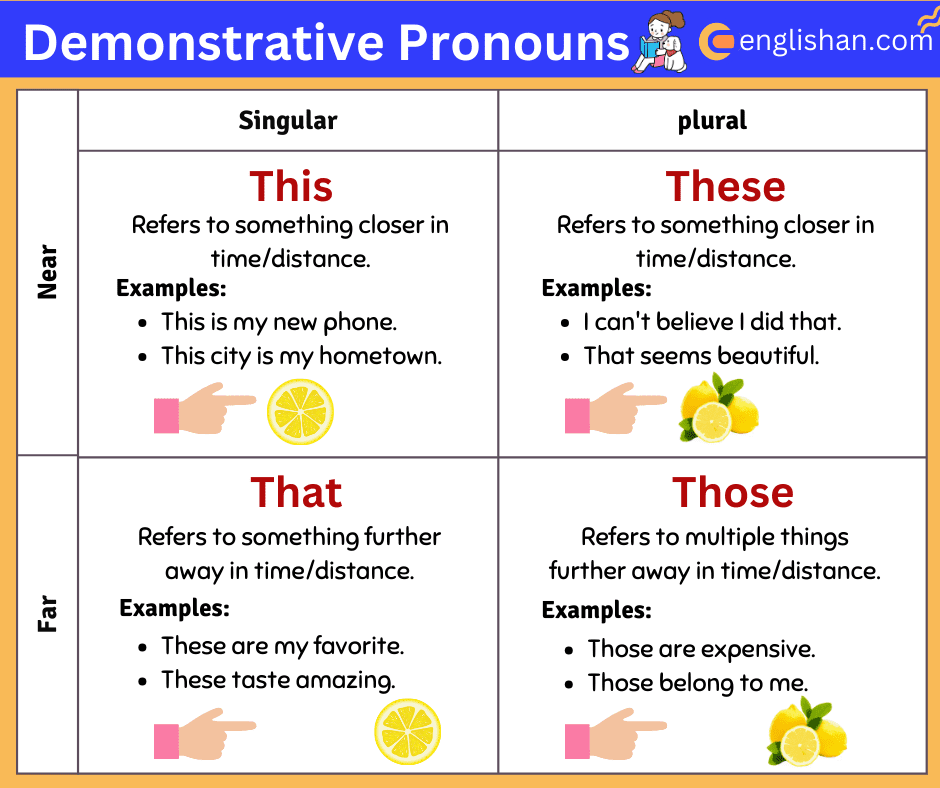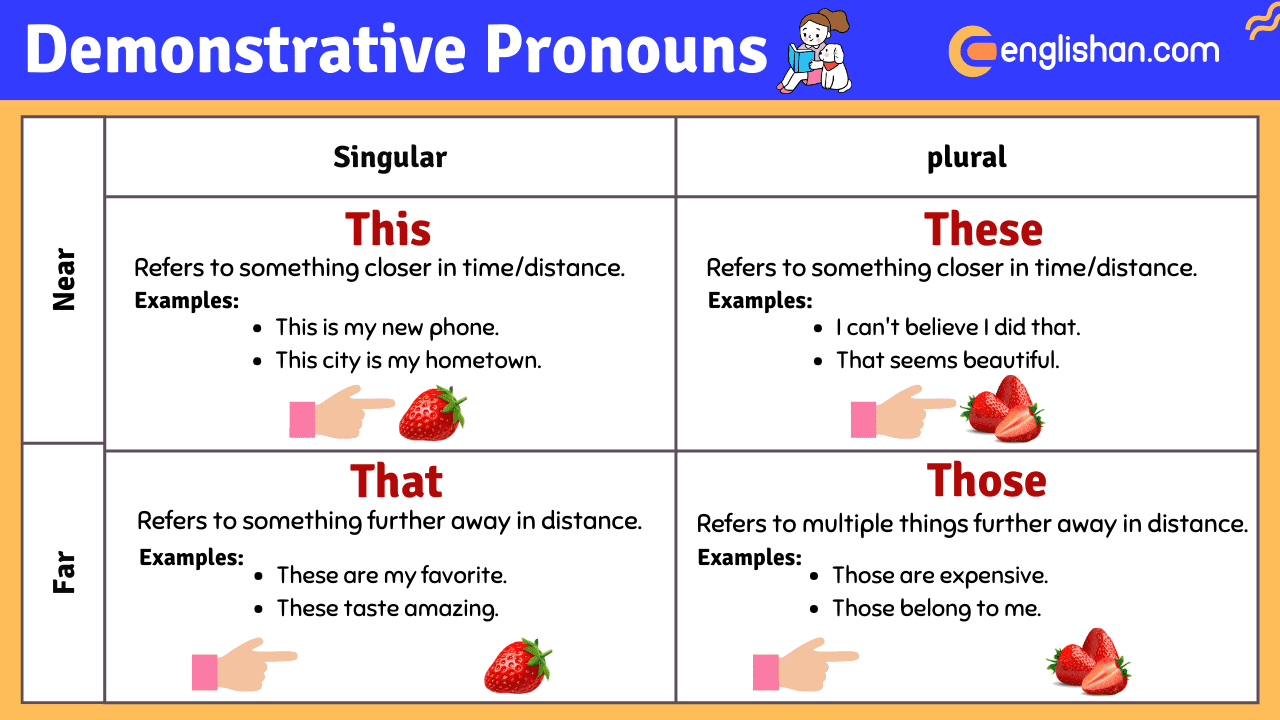Contents
Pronouns are words we use to replace nouns and prevent repetition in sentences. There are various types of pronouns, and here, we’ll discuss a specific type called demonstrative pronouns. These special pronouns point out or show specific people, places, or things in a conversation, helping everyone understand exactly what’s being discussed. Common demonstrative pronouns include ‘this,’ ‘that,’ ‘these,’ and ‘those.’ In this article, we’ll explore what demonstrative pronouns are with their uses and examples. So, let’s begin!
What are Demonstrative Pronouns?
Demonstrative pronouns are used to talk about people, places, or things in relation to where the speaker and listener are. These pronouns take the place of nouns and help show how close or far something is.
The most common demonstrative pronouns are:
this, that, these, those
- This and that are for one thing (singular).
- These and those are for more than one (plural).
This points to something close to the speaker.
That shows something farther away.
Examples:
- This chair is soft. (The chair is near.)
- That chair is soft. (The chair is farther away.)
- These shoes fit well. (Shoes are nearby.)
- Those shoes fit well. (Shoes are farther away.)
Types of Demonstrative Pronouns
Demonstrative pronouns come in four main types: “this,” “that,” “these,” and “those.” Each type serves a specific purpose in indicating the proximity or distance of people, places, or things in a conversation or text.
- This:
- Used to refer to a singular item or person that is close to the speaker. For example, “This book is interesting,” indicating the proximity of the book to the speaker.
- That:
- Indicates a singular item or person that is farther away from the speaker. For instance, “That is my pen,” signaling something at a distance from the speaker.
- These:
- Refers to multiple items or people that are close to the speaker. For example, “These shoes are comfortable,” highlighting the proximity of the shoes.
- Those:
- Points out multiple items or people situated farther away. For instance, “Can you pass me those (pencils)?” indicating that the pencils are not nearby.

Chart of Demonstrative Pronouns
| Demonstrative Pronoun | Uses | Examples |
|---|---|---|
| Singular (Near) | Refers to something closer in time/distance. | This is my new phone. |
| This city is my hometown. | ||
| Can you pass me this (book)? | ||
| Singular (Far) | Refers to something further away in time/distance. | That movie was released last year. |
| I can’t believe I did that. | ||
| That seems beautiful. | ||
| Plural (Near) | Refers to multiple things closer in time/distance. | These are my favorite (shoes). |
| These (cookies) taste amazing. | ||
| I bought these at the local market. | ||
| Plural (Far) | Refers to multiple things further away in time/distance. | Those are expensive. |
| Those belong to me. | ||
| Can you grab those tools from the garage? |
How to Use Demonstrative Pronouns?
Demonstrative pronouns like this, that, these, and those help replace specific nouns and show how close or far something is from the speaker or listener. Here’s how to use them correctly:
- Proximity matters:
Use this or these for things close to you.
Use that or those for things farther away. - Singular or plural:
Choose this for one close thing.
Choose that for one far thing.
Use these for many close things.
Use those for many things that are far. - Be clear:
Pick the right pronoun so your listener knows exactly what you’re talking about. - Stay consistent:
If you start with this, keep using this for the same object or idea.
Demonstrative Pronouns vs Demonstrative Adjectives
Although both types of words indicate proximity and help identify specific things, demonstrative pronouns stand-alone, and replace nouns directly, while demonstrative adjectives modify nouns by providing additional information. For example:
In the sentence “This book is interesting,” “this” is a demonstrative pronoun because it replaces the noun “book,” whereas in the sentence “I like this book,” “this” is a demonstrative adjective because it describes the noun “book.”
Demonstrative Pronouns Examples
- This is my favorite song.
- These are delicious cookies.
- This is my house.
- Is that yours?
- Those are expensive.
- These belong to me.
- Those are beautiful flowers.
- I need this right now.
- This is the one I want.
- Those were incredible fireworks.
- This seems easy.
- Are those (chairs) comfortable?
- I choose this one.
- These need to be fixed.
- I love this (color).
- What are these for?
- I can’t find this (book).
- These shoes are stylish.
- I love this room’s color.
- Do you like those (headphones)?
Demonstrative Pronouns Exercises
Choose the correct answer from the options provided (this, that, these, those) to check your knowledge:
Q1: Which of the following is a demonstrative pronoun?
- The
- That
- Some
- His
Q2: “___ is my favorite color.”
- They
- These
- Those
- It
Q3: “___ are my friends.”
- Those
- Many
- Few
- Every
Q4: Which word is a demonstrative pronoun?
- Her
- Them
- Here
- This
Q5: ___ are the best days of our lives.
- This
- That
- These
- Those
Q6: “___ is a beautiful day.”
- His
- That
- Few
- Any
Q7: I can’t believe ___ is happening right now!
- this
- that
- these
- those
Q8: “___ is my favorite movie.”
- Their
- Them
- That
- Each
Q9: “___ are my favorite shoes.”
- Those
- They
- Both A and B
- Neither A nor B
Q10: “___ are the best flowers in the garden.”
- Many
- Some
- These
- Every
Answers:
- b) That
- c) Those
- a) Those
- d) This
- c) These
- b) That
- a) This
- c) That
- a) Those
- c) These
FAQs:
Demonstrative pronouns are words that replace nouns and point out specific people, places, or things in a sentence. They indicate whether the noun being referred to is near or far in distance, and they include words like “this,” “that,” “these,” and “those.”
Demonstrative pronouns differ from demonstrative adjectives in their function within a sentence. For example: demonstrative pronouns replace nouns entirely, standing alone to point out specific objects or people (I want this right now). Demonstrative adjectives, on the other hand, modify nouns, providing more information about the noun (I like this book).
There are four main types of demonstrative pronouns: “this,” “that,” “these,” and “those.” They can vary in number and distance, referring to singular or plural nouns and indicating proximity or distance from the speaker.
Read More
